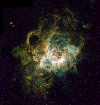All stars are formed from interstellar gas and dust clouds. Depending on how much material goes into the formation of a given star, its life can take one of two different courses.
Star birth
 Throughout
space, there are huge, very thin clouds of gas and dust called nebulae.
Some of the nebulae are sites of star birth; these are called Giant
Molecular Clouds (GMCs).
Throughout
space, there are huge, very thin clouds of gas and dust called nebulae.
Some of the nebulae are sites of star birth; these are called Giant
Molecular Clouds (GMCs).
Slowly, gravity within the cloud results in its collapse, perhaps triggered
initially by a nearby disturbance such as a supernova explosion (see below).
These clumps of matter are called proto-stars. Eventually, if there is
enough matter, nuclear reactions will commence deep in the interior of
such an object, and a star is born. The most important process is the
conversion of hydrogen into helium, which releases a huge amount of energy.
At this point, the life of the star can take two distinct courses, depending
on its mass.
Lives of stars with low and intermediate
masses
Astronomers usually describe the masses of stars in relation to the mass
of the Sun. Stars with masses up to about 2.5 solar masses are called
low-mass stars, while heavier stars of up to about 8 solar masses are
called intermediate-mass stars.

|
Life of a low mass star |
The lifetime of a star is very dependent on its mass: surprisingly, stars with higher masses live for shorter periods of time! Our Sun's lifetime is about 10 billion years, but a star of half the mass of the Sun will live for much longer - about twenty times as long as our Sun.
When the hydrogen in the star's core is exhausted, the core will contract and heat, resulting in hydrogen burning around the core. New reactions commence in the core itself, converting helium to carbon. The star expands to form a red giant. When the Sun does this, about 5 billion years from now, it will engulf the orbits of Mercury and Venus.
The outer layers of the star become unstable and are blown off, leaving just the core, known as a White Dwarf star. Such a star is typically about the size of the Earth, but very dense: a teaspoon of white dwarf material would have a mass of about a tonne. Eventually, the star will cool down very slowly.
Life of a high mass star
Stars more than eight times larger than our Sun follow a very different
life. High mass stars consume their hydrogen fuel very quickly, taking
only 50 to 100 million years before their core collapses and their outer
layers expand quickly to form a "Super Giant".
Eventually, the star runs out of fuel and collapses suddenly causing a "Super Nova", a tremendous explosion, and the most violent event known to happen in the Universe. The light from Super Nova is a bright as a whole galaxy for a few days. The material left after the Super Nova can now either form a super dense "Neutron Star" or a "Black Hole", two very strange and powerful objects that are only now being investigated by astronomers and scientists.

|
Life of a high mass star |
| Copyright owned by the State of Victoria (Department of Education and Early Childhood Development). Used with Permission. |
|
|||||||||||||||||||||||||||||||||||||||||||||||||||||||||||||||||||||||||||||||||||||